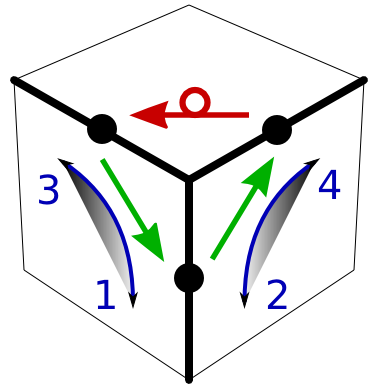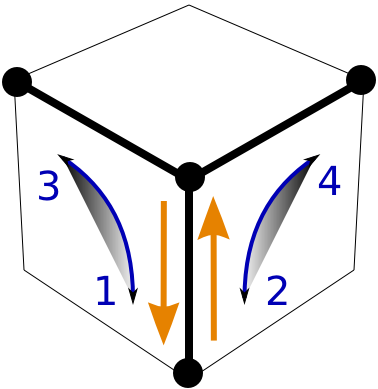A Beginner's Method
to Solve The Cube
Basics
Solving the Cube
- Step 1: Bottom Edges
- Step 2: Bottom Corners
- Step 3: Middle Edges
- Step 4: Top Edges
- Step 5: Solve Edges
- Step 6: Position Corners
- Step 7: Solve Corners
- Done
Extras
Credits and Links
Where I started and related methods
When discussing solution methods, there are different basic strategies in which order to solve the cubies, say layer-by-layer (LBL) methods or edges-first methods, etc. And there are different collections of algorithms that are used to perform the various solution steps.
The method I describe follows a layer-by-layer strategy with a "free column" as workspace. In contrast to a standard LBL method where, say, the bottom, middle, and top layer are solved completely, we leave a few cubies unsolved during the early stages. The idea is that this gives us some free space to solve certain cubies more easily. I have seen this strategy first in 2008 in one of the Wikibook solutions for beginners. We will refer to it as the Wikibook-2008 solution.
For my version, I made one key modification to the basic strategy related to counting swaps, but more importantly I use a different set of moves. The Wikibook-2008 solution suggests five or more algorithms (depending on how you count). The main idea is to reduce the number of required algorithms to essentially just one. The revised method gets by with only one basic four-turn sequence, the Y-move F Ri Fi R. We could call it the Y-method or LBL-Y.
Looking around in 8/2014, I think what I propose is closely related to Reheart Sheu's 8355 method or its more recent refinement, Conrad Rider's Single Alg Cube Solution, and to Philip Marshall's Ultimate Solution to the Rubik's Cube. Let me abbreviate them by 8355, SAM, and USRC. These methods are designed to solve the cube with 3, 1, or 2 algorithms, respectively.
(Update.) On 10/17/2014 there was an addition to the SpeedSolving wiki of Camilo Amaral's method, pointing to a Youtube Video of 5/2014 and citing USRC as inspiration. Developed independently, Amaral's method and the Y-method are both single algorithm methods built around the Y-move, with some interesting differences in the solution steps. (End update.)
8355 and SAM follow the same layer-by-layer with workspace strategy as the LBL-Y method. The 8355 method is one of several beginner methods at the SpeedSolving site, requiring only 3 different algorithms. One of them is a close cousin of the Y-move, which for the front and right faces is the "S-move", F R Fi Ri. The other two algorithms are of the type R U Ri U R U Ri and Ri Ui Ri Ui Ri U R U R. The single alg method (SAM) is a variant of 8355 that essentially just uses that Y-move cousin, S = F R Fi Ri.
The USRC method is an edges-first method. Notice that the second step of the LBL method is to solve four corners, but this can be delayed until all the edges are solved. The type of LBL with workspace method that we consider here is closely related to edges-first methods because the same moves that are used to solve the last few corners can be used to solve all corners after all edges have been solved. The USRC method uses the Y-move (called the edge piece series by P.M.), and the corner piece series F R Fi Li F Ri Fi L.
In summary, I would say that the Y-method is like SAM a single algorithm version of the 8355 method, but replacing the move S-move FRFiRi of 8355 and SAM by the Y-move FRiFiR. The Y-method with an edges-first strategy can also be viewed as a single algorithm version of USRC, where we do the edges with Y, but the corner piece series is replaced by two Y-moves. Another, independently developed single algorithm version of USRC is Amaral's method, which however follows different solution steps compared to the Y-method.
In contrast to the other methods, the Y-method suggests to count swaps to simplify the moves for the last three edges. This seems to avoid several of the special cases that Wikibook-2008, 8355, SAM, USRC, and Amaral have to consider to solve the last edges.
Just for fun, for example have a look at the 42 algorithms of F2L to see what expert methods can look like.
In conclusion, there are several "minimal algorithm" solutions of the Rubik's cube. Once we cut the number down to 3, 2, or even just 1 algorithm, there aren't that many options. Compared to advanced methods with 50, 100 or more algorithms, the minimal algorithm methods are rather similar and closely related to each other. Searching the web, however, there are many more "beginner methods" that use 5 to 10 algorithms that can be traced back to the classic layer-by-layer solutions from the 1980s.
Some key links
There is a large number of nice resources out there. Without any attempt at completeness:
- The one and only, the original Rubik's Cube. Certainly worth a look, has video and PDF solution guides. The solution is the standard layer-by-layer method. See also You CAN do the Rubik's Cube.
- Wikipedia has a nicely informative page, many links.
- SpeedSolving.com may well be the most active website for anything related to the Cube, not just speed solving. Their Wiki has the largest selection of different solution strategies that I have found in 2014.
- There is a Wikibook describing several strategies. Perhaps a little outdated in 2014, but that may change again.
Quite a number of people have made their own pages:
- Ryan Heise's site. Lots of stuff. Recommended for a brief review of fundamental techniques and theory, the laws of the cube etc.
- Denes Ferenc's site. Again, lots of stuff, new and up-to-date.
- Andy Klise's site. Nice collection of advanced guides, also PDF.
- Josef Jelinek's site. One of the classics.
- There are too many to mention. Please refer to the links at those sites and at Wikibooks!
The Javascript/WebGL Cube Applet
| The 3d cube on these pages is based to 99% on the excellent WebGL Rubik's Cube by Werner Randelshofer. Parts of the code are from the WebGL demo repository. If the applet does not display, you may need to use a different browser, although modern browsers (2014) should have no problems. You can move the cube in 3d by dragging it with the mouse. Reset with ' * '. |
For these pages I added my own minimal interface to demonstrate moves, inspired by Jelinek's Java applet, which is the de facto standard on many sites. I decided to move away from Java to JavaScript/WebGL for this site for increased compatibility. Another recent and very promising JavaScript alternative can be found at alg.cubing.net.
Known quirks after limited testing (9/2014):
- Depending on hardware/software, there is a limit to the number of WebGL contexts. On my laptop that's 16. If there are more cubes on a page, some will be left white. If this is an issue, say on smartphones, it may be nice to make a one cube per page version.
- Reload the page if there are problems after suspend.
Version History
Version 7/2009: Basic method, Jelinek's Java applet, could not resolve all Java/browser issues.
Version 9/2014: Fully functional, Randelshofer's JavaScript/WebGL applet, version 2011.
Version 8/2018: Applet stopped working on recent browsers, fixed problems with new JavaScript interface for Randelshofer's version 2012.

